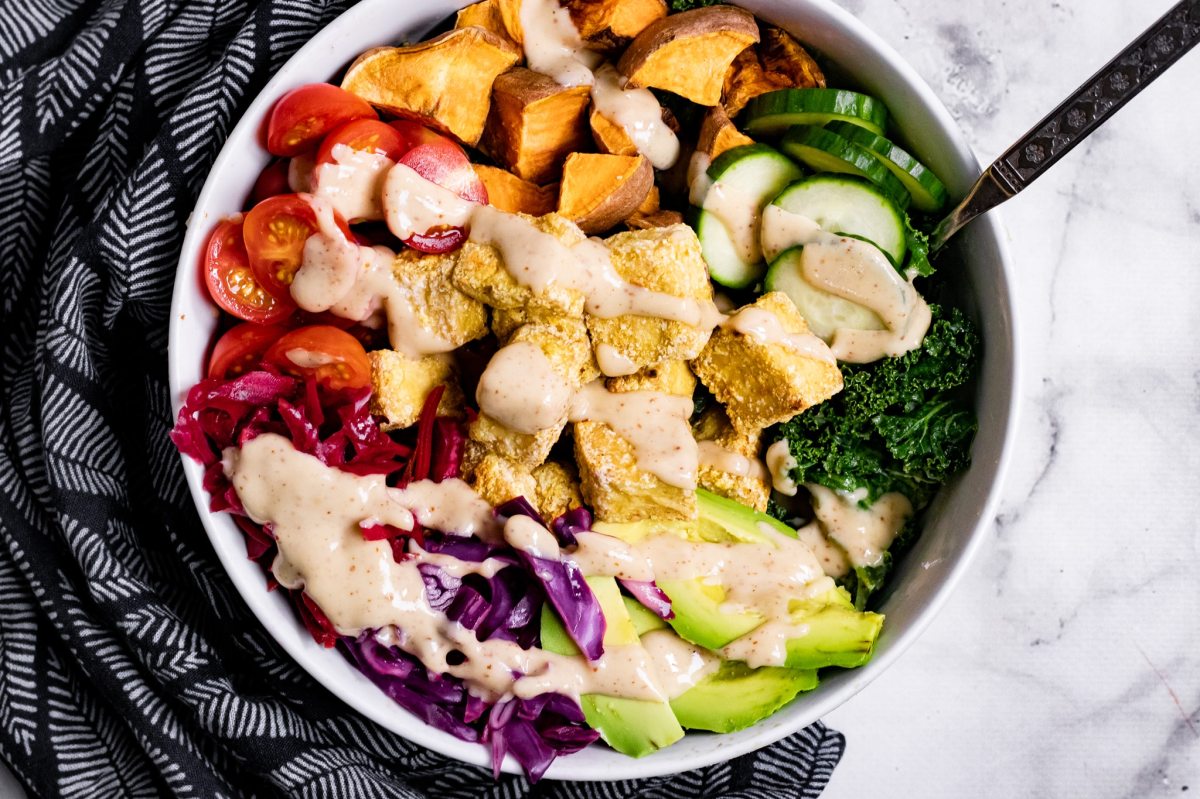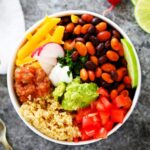Discover the vibrant world of flexitarian Buddha bowls! This comprehensive guide unveils the art of crafting perfectly balanced and visually stunning bowls, showcasing the versatility of a flexitarian diet. We’ll explore three unique recipes featuring tofu, chickpeas, and grilled chicken, each brimming with fresh, seasonal ingredients and bursting with flavor. Learn to master the art of building your own bowl, from selecting the perfect grains and vegetables to achieving optimal texture and color combinations. We’ll also delve into the sustainability of your ingredients and explore creative presentation techniques to elevate your culinary artistry.
Beyond the recipes, we’ll examine the principles of flexitarian eating, its health benefits, and how it compares to other dietary approaches. This guide is your complete resource for creating delicious, healthy, and visually captivating flexitarian Buddha bowls that nourish your body and soul.
Step-by-Step Guide
Crafting the perfect flexitarian Buddha bowl is a journey of vibrant colors, delightful textures, and harmonious flavors. This step-by-step guide will walk you through the process, ensuring your creation is both visually stunning and incredibly delicious. Remember, the beauty of a Buddha bowl lies in its adaptability; feel free to substitute ingredients based on your preferences and what’s seasonally available.
Grain Preparation
Properly cooked grains form the foundation of a satisfying Buddha bowl. The grains provide a hearty base, absorbing the flavors of the other ingredients and offering a textural contrast to the crisp vegetables and protein. Choosing the right grain depends on your preference – quinoa offers a complete protein, brown rice provides a nutty flavor, and farro adds a chewy texture.
- Rinse your chosen grain thoroughly under cold water to remove any excess starch.
- Combine the rinsed grain with twice its volume of water (or follow package instructions) in a saucepan.
- Bring the mixture to a boil, then reduce heat to low, cover, and simmer until the grain is tender and the water is absorbed. This typically takes 15-20 minutes for quinoa and brown rice, and longer for farro.
- Once cooked, fluff the grain with a fork and set aside to cool slightly before adding it to your bowl.
Vegetable Selection and Preparation
The vegetables are the stars of the show in a Buddha bowl, contributing a spectrum of colors, textures, and tastes. Aim for a variety of colors for visual appeal and a mix of textures – crunchy, soft, and slightly sweet. Consider seasonal vegetables for optimal flavor and freshness.
- Choose a selection of vegetables that complement each other in terms of flavor and texture. Examples include roasted sweet potatoes (offering a sweet and soft texture), crisp broccoli florets, shredded carrots (adding a vibrant orange hue), and thinly sliced red cabbage (providing a satisfying crunch and deep purple color).
- Prepare your vegetables according to their needs. Roasting sweet potatoes brings out their natural sweetness, while steaming broccoli preserves its vibrant green color and crispness. Carrots and red cabbage can be enjoyed raw or lightly sautéed.
- Consider adding a vibrant green element like spinach or kale, either raw or lightly wilted. These leafy greens add nutrients and a pop of color.
Protein Addition
The protein component completes the Buddha bowl, adding satiety and flavor complexity. Flexitarian options abound, allowing you to adapt the bowl to your dietary needs and preferences.
- Choose a protein source that complements the other ingredients. Grilled chicken or fish adds a lean protein, while chickpeas or lentils offer a vegetarian alternative packed with fiber and plant-based protein.
- Prepare your protein according to your preference. Grilled chicken or fish can be marinated for added flavor, while chickpeas or lentils can be roasted for a crispy texture or added directly to the bowl.
- Ensure the protein is cooked thoroughly before adding it to the bowl.
Assembling the Bowl
The final step is assembling your masterpiece. Start with the grains as the base, then layer the vegetables and protein, creating a visually appealing and delicious bowl.
- Place a generous portion of cooked grains in the bottom of your bowl. This forms a sturdy base for the remaining ingredients.
- Arrange the prepared vegetables artfully on top of the grains, creating a colorful and visually appealing design. Consider layering vegetables with varying heights and textures for a more dynamic presentation.
- Add your chosen protein to the bowl, distributing it evenly amongst the vegetables.
- Finish with a drizzle of your favorite dressing – a simple vinaigrette, tahini dressing, or a creamy peanut sauce all work beautifully.
Ingredient Sourcing and Sustainability

Crafting the perfect flexitarian Buddha bowl goes beyond just the recipe; it’s about mindful ingredient sourcing that respects both our bodies and our planet. Choosing fresh, seasonal, and local produce significantly impacts the flavor, nutritional value, and environmental footprint of your creation. By prioritizing sustainability, we can savor delicious bowls while minimizing our impact on the earth.
The vibrant colors and textures of a Buddha bowl are a testament to the bounty of nature. However, the journey from farm to bowl often involves considerable environmental costs. Understanding these impacts and making conscious choices about our ingredients empowers us to build a more sustainable food system. This includes considering the transportation distances, farming practices, and overall resource consumption associated with each ingredient.
Sustainable Sourcing Practices for Buddha Bowl Ingredients
The key to sustainable Buddha bowls lies in selecting ingredients produced with minimal environmental impact. This involves considering the entire supply chain, from seed to plate. For example, opting for organically grown grains reduces pesticide use and protects soil health. Similarly, choosing locally sourced vegetables minimizes transportation emissions, keeping your carbon footprint smaller. Supporting farmers who employ regenerative agricultural practices, like crop rotation and cover cropping, further enhances soil fertility and biodiversity.
Environmental Impact of Common Buddha Bowl Ingredients and Sustainable Alternatives
Certain Buddha bowl staples carry a heavier environmental burden than others. For instance, the production of quinoa, while nutritious, can be water-intensive in certain regions. A more sustainable alternative, depending on location and seasonality, could be brown rice or farro, both requiring less water. Similarly, conventionally grown avocados often involve significant pesticide use and water consumption; opting for locally grown, organically certified avocados, or even substituting with a seasonal alternative like butternut squash, can reduce these impacts. The transportation of ingredients also plays a role; choosing locally sourced ingredients significantly reduces the carbon emissions associated with long-distance shipping. For example, opting for locally grown kale instead of kale imported from another continent reduces fuel consumption and pollution.
Creating the perfect flexitarian Buddha bowl is more than just assembling ingredients; it’s an artistic expression of mindful eating and a celebration of fresh, seasonal produce. From mastering the art of layering textures and colors to understanding the nutritional benefits of various protein sources and sustainable sourcing practices, this journey has equipped you with the knowledge and inspiration to craft bowls that are as visually stunning as they are delicious. Embrace the flexibility of the flexitarian approach, experiment with different flavor combinations, and enjoy the rewarding experience of creating your own personalized culinary masterpieces.
Essential FAQs
Can I make these bowls ahead of time?
Yes! Prepare the components (grains, roasted vegetables, protein) separately ahead of time and assemble just before serving to maintain optimal freshness and texture.
Are these bowls suitable for meal prepping?
Absolutely! Prepare large batches of grains, roasted vegetables, and protein sources to create multiple bowls throughout the week. Store components separately in airtight containers for optimal freshness.
What if I don’t like one of the suggested protein sources?
Feel free to substitute! Other excellent protein options include lentils, quinoa, edamame, or even tempeh. Choose proteins that align with your dietary preferences and taste.
Can I adjust the spice levels?
Certainly! Adjust the amount of chili flakes, spices, or hot sauces to your preferred level of heat.


